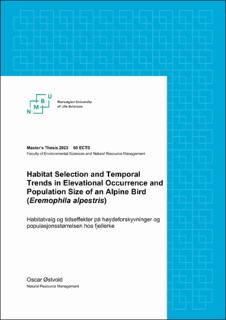| dc.contributor.advisor | Svein Dale | |
| dc.contributor.author | Østvold, Oscar | |
| dc.date.accessioned | 2023-07-13T16:27:58Z | |
| dc.date.available | 2023-07-13T16:27:58Z | |
| dc.date.issued | 2023 | |
| dc.identifier | no.nmbu:wiseflow:6839647:54592828 | |
| dc.identifier.uri | https://hdl.handle.net/11250/3078685 | |
| dc.description.abstract | Klimaet er i endring og dette fører til at fugl og andre artsgrupper endrer utbredelse mot polene og forflytter seg høyere i terrenget. Disse endringene fører til nedgang i habitat og er antatt å være en av grunnene til de globale nedgangene i fuglepopulasjoner. Bestanden av fjellerke er ukjent, og det har både blitt rapportert nedgang og oppgang i Norge. For å innhente mer kunnskap om, og avdekke habitatpreferanser, samt mulige endring i foretrukket høyde og populasjonstrenden hos fjellerke, ble 44 områder taksert på Dovrefjell i hekkeperioden for fjellerke i 2022 (mai-juni). Videre ble også data fra Artsobservasjoner.no og tidligere rapporter brukt for å lage tidsserier for høyde mellom 1971–2021 og bestand mellom 2007–2021. Habitatanalysen som ble utført viste at fjellerka foretrekker intermediære og kalkrike områder med moderat beiting. Det har vært en forskyvning i høyde for fjellerka med 2.17 m/år siden 1971 og 3.65 m/år siden 2008. Det ble i tillegg observert signifikante forskjeller mellom feltobservasjoner fra Grimsdalen (1969 gjennomsnitt = 1337 m, 2022 gj. snitt = 1426 m) og i Einunndalen (1992 gj. snitt = 1337 m, 2022 gj. snitt = 1414 m). Populasjonen av fjellerke på Dovrefjell har vært stabil siden 2007, men med endring i foretrukket høyde vil det gradvis bli mindre tilgjengelig habitat. Derfor er det viktig at forvaltningen regulerer beiting i høyfjellet og forhindrer både gjengroing og degradering av alpine gressheier. Videre er det vesentlig at bestanden av fjellerke blir overvåket for eventuelle nedganger som følge av endring i klima og menneskers bruk av fjellet. | |
| dc.description.abstract | The global climate is changing, and this forces avifauna, vegetation, insects, and other animal species to shift their distribution towards higher elevation and latitude. These shifts can lead to population decreases and could be one of the causes of the observed declines in avifauna. The horned lark (Eremophila alpestris) is reportedly not in decline in Norway, but declines have been observed in some areas and neighbouring countries, and with limited data the population trend is uncertain. To assess the habitat preference and if there has been elevational shifts and changes in population size, 44 sites were surveyed in the region of Dovre in the breeding season (May-June). Further, citizen data from the Norwegian Biodiversity Information Centre were used to analyse elevational changes over time between 1971 and 2021 and population size between 2007 and 2021. In addition, two reports were used to compare the findings of this study to older surveys from the region. Habitat analyses showed that horned larks preferred nutrient-rich sites with moderate grazing, where a high density of sheep had negative effects. The elevational analyses showed that there has been an elevational shift of 2.17 m upwards per year since 1971 and 3.65 m/year since 2008 for southern Norway. Significant changes were also observed for a selection of surveyed study sites in Grimsdalen (1969 mean = 1337 m, 2022 mean = 1426 m) and in Einunndalen (1992 mean = 1337 m, 2022 mean = 1414 m). The population has been stable between 2007 and 2021, but with elevational shifts the available and preferred habitats will decrease over time. Managers should also note the importance of grazing and regulate this in the mountains to keep open grasslands in alpine regions. Climate change and associated changes in alpine habitats is likely to change the population trend of the horned lark and should be monitored for potential population decreases. | |
| dc.language | eng | |
| dc.publisher | Norwegian University of Life Sciences | |
| dc.title | Habitat Selection and Temporal Trends in Elevational Occurrence and Population Size of an Alpine Bird (Eremophila alpestris) | |
| dc.type | Master thesis | |
